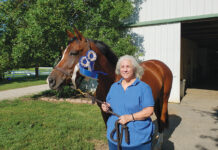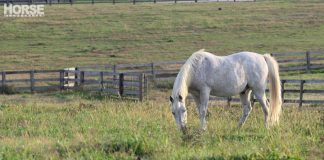Housefly:
This fly is commonly found milling around your horse’s face in order to lap moisture from his eyes and nose with its sponging mouthparts. It will also feed on wounds. The housefly favors sweet things as well, such as the molasses found in some feeds. It is the most common of all the flying pests. Although it isn’t a biting fly, it can still act as a vector to spread diseases. A prolific breeder, one housefly can lay over 1,000 eggs within two weeks.
Stable fly:
This biting fly resembles the housefly but has a pin-like mouthpart. It sits on your horse’s lower legs and flanks where it bites into the skin to suck blood with its sharp, tube-like beak.
The stable fly is a strong flier and can travel miles. It prefers wet manure and moist, decaying matter such as straw, hay bales and uncovered compost piles. Remove all rotting and wet debris, spread manure thinly, and flatten old round hay bales.
Control Strategies: Compost properly and turn or stack manure piles. Release parasitic wasps or use feed-through products to disrupt the breeding cycle. The adult stable fly resists bait and sticky traps, so kill adults with prism traps set in the sunlight a couple of feet off the ground. Repel flies on the horse with spray, leg wraps and a fly sheet.
Mosquito:
The mosquito’s bite is itchy and unpleasant, but the potential harm doesn’t stop there; mosquitoes can carry West Nile virus and Eastern Equine Encephalitis.
Control Strategies: Dump out any unnecessary standing water and use mosquito tablets approved for use in drinking water. Employ carbon dioxide mosquito and biting insect traps to kill adults. Repel mosquitoes with fly spray and a fly sheet.
Horsefly and Deerfly
In the deep South, the yellow fly is included in this category. These strong fliers make horses extremely miserable in the late spring and summer months. Females need a blood meal to complete the development of their eggs, which are laid in marshy ground. They are vectors for the Equine Infectious Anemia (EIA) virus. Flies settle on their prey and use their saw tooth to slash the skin. They don’t like the shade, so horses will often head for shelter when these biting flies attack. Most fly sprays aren’t effective against horseflies and deerflies.
Control Strategies: Use the Horse Pal Fly Trap to stop the breeding cycle, repellent that specifically targets these species, and a sturdy fly sheet to weaken attacks.
Horn Fly
The blood-feeding horn fly is typically found on cattle because it needs wet, undisturbed cow manure for breeding–it can’t develop in horse manure. But if cattle are kept near horses, horn flies will happily feed on them (as well as any other livestock and dogs). Horn flies mill around the animal’s back or on the belly during wet or hot days.
Control Strategy: Use parasitic wasps to break the cycle and use fly spray and a fly sheet to repel adults.
Further Reading
Field Guide to Flies
Natural Fly Control






